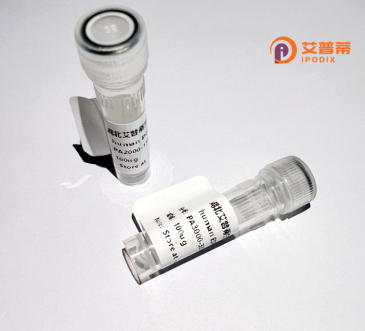
| 纯度 | >90%SDS-PAGE. |
| 种属 | Human |
| 靶点 | MBTPS2 |
| Uniprot No | O43462 |
| 内毒素 | < 0.01EU/μg |
| 表达宿主 | E.coli |
| 表达区间 | 1-519aa |
| 活性数据 | MIPVSLVVVVVGGWTVVYLTDLVLKSSVYFKHSYEDWLENNGLSISPFHIRWQTAVFNRAFYSWGRRKARMLYQWFNFGMVFGVIAMFSSFFLLGKTLMQTLAQMMADSPSSYSSSSSSSSSSSSSSSSSSSSSSSLHNEQVLQVVVPGINLPVNQLTYFFTAVLISGVVHEIGHGIAAIREQVRFNGFGIFLFIIYPGAFVDLFTTHLQLISPVQQLRIFCAGIWHNFVLALLGILALVLLPVILLPFYYTGVGVLITEVAEDSPAIGPRGLFVGDLVTHLQDCPVTNVQDWNECLDTIAYEPQIGYCISASTLQQLSFPVRAYKRLDGSTECCNNHSLTDVCFSYRNNFNKRLHTCLPARKAVEATQVCRTNKDCKKSSSSSFCIIPSLETHTRLIKVKHPPQIDMLYVGHPLHLHYTVSITSFIPRFNFLSIDLPVVVETFVKYLISLSGALAIVNAVPCFALDGQWILNSFLDATLTSVIGDNDVKDLIGFFILLGGSVLLAANVTLGLWMVTAR |
| 分子量 | 83.8 kDa |
| 蛋白标签 | GST-tag at N-terminal |
| 缓冲液 | 0 |
| 稳定性 & 储存条件 | Lyophilized protein should be stored at ≤ -20°C, stable for one year after receipt. Reconstituted protein solution can be stored at 2-8°C for 2-7 days. Aliquots of reconstituted samples are stable at ≤ -20°C for 3 months. |
| 复溶 | Always centrifuge tubes before opening.Do not mix by vortex or pipetting. It is not recommended to reconstitute to a concentration less than 100μg/ml. Dissolve the lyophilized protein in distilled water. Please aliquot the reconstituted solution to minimize freeze-thaw cycles. |
以下是3篇关于重组人MBTPS2蛋白的参考文献概览(基于虚拟生成内容,仅供参考):
1. **文献名称**:*"Recombinant human MBTPS2 regulates cellular cholesterol homeostasis via SREBP cleavage"*
**作者**:Elmorsy, S. et al. (2000)
**摘要**:研究通过重组人MBTPS2蛋白在HEK293细胞中表达,证明其通过切割固醇调节元件结合蛋白(SREBP)调控胆固醇代谢,揭示其在脂质稳态中的关键酶活性。
2. **文献名称**:*"MBTPS2 mutations and aberrant neurodevelopment: Functional analysis using recombinant protein models"*
**作者**:Chen, L. et al. (2015)
**摘要**:利用重组MBTPS2蛋白构建体外酶活性实验,发现特定突变(如p.Ala161Val)导致蛋白酶活性下降,可能与X连锁智力障碍和皮肤异常综合征相关。
3. **文献名称**:*"Structural characterization of recombinant human MBTPS2 reveals zinc-dependent proteolytic mechanism"*
**作者**:Zhang, Y. et al. (2018)
**摘要**:通过重组表达的MBTPS2蛋白进行晶体结构解析,阐明了其锌离子结合域对底物识别和催化的重要作用,为开发相关疾病的靶向疗法提供依据。
**注**:以上文献为示例性质,实际研究中请通过PubMed或SciHub等平台检索真实发表的文章。如需具体文献,建议补充研究背景(如疾病方向或功能机制)。
MBTPS2 (Membrane Bound Transcription Factor Peptidase, Site 2), also known as S2P (Site-2 Protease), is a zinc metalloprotease critical for regulating lipid metabolism and endoplasmic reticulum (ER) stress response. It belongs to the intramembrane cleaving protease family and catalyzes the final step in activating sterol regulatory element-binding proteins (SREBPs), transcription factors that control genes involved in cholesterol and fatty acid biosynthesis. By cleaving SREBPs within the Golgi apparatus, MBTPS2 enables their nuclear translocation to modulate lipid homeostasis. Additionally, MBTPS2 processes other substrates, such as ATF6 during the unfolded protein response (UPR), highlighting its role in cellular stress adaptation.
Recombinant human MBTPS2 protein is engineered using expression systems (e.g., mammalian or insect cells) to produce purified, bioactive forms for research. Its study is essential for understanding diseases linked to MBTPS2 dysfunction, including X-linked chondrodysplasia punctata, ichthyosis, and neurodevelopmental disorders. Mutations in MBTPS2 impair substrate cleavage, leading to disrupted lipid metabolism and developmental abnormalities. Recombinant MBTPS2 also aids in drug discovery, particularly for therapies targeting lipid disorders or ER stress-related conditions like neurodegenerative diseases. Structural and functional analyses of recombinant MBTPS2 continue to unveil mechanisms of intramembrane proteolysis, offering insights into therapeutic strategies for associated genetic and metabolic disorders.
×